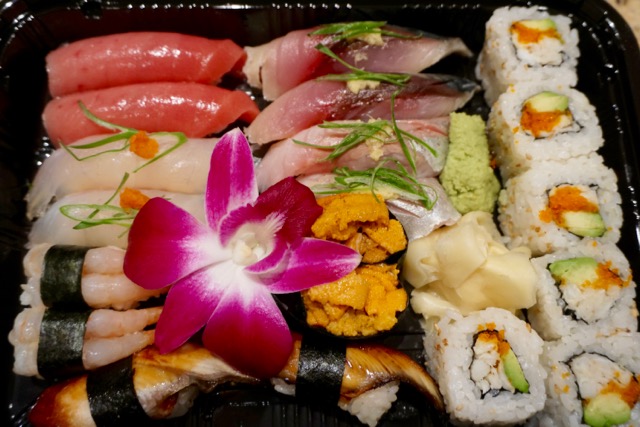I found 2 frozen pacific saury or sanma サンマ in the freezer which I bought a few months ago. Since they do not improve with prolonged freezing and the weather is not conducive to
grilling outside, I decided to make something different. Since I already made
sanma fry, I looked for other recipes. These are based on the
recipes I saw on line. Both dishes are made from filets of sanma, rolled and deep fried. I made some modifications, of course. In the picture below, the left is cheese filled with scallion miso and perilla, breaded and fried. The one on the right is filled with pickled plum paste or "bainiku" 梅肉 and perilla. It was coated with potato starch and deep fried like kara-age 唐揚げ. Initially I was debating which dish to make and was leaning toward the pickled plum since it seemed simpler and I was afraid the cheese would melt and run out of the other one. When I described the recipes to my wife she said, "live on the wild side; go for the cheese". So I decided to compromise and make both; if worse came to worse at least the pickled plum one would probably come out ok.
Since the inside of the roll with cheese, could not be seen, I sliced off the bottom to display the center of melting cheese, a green layer of perilla and dark brown line of the scallion miso below.
I thawed two sanma and filleted them or "sanmai ni orosu" 三枚におろす in Japanese culinary parlance
as I posted before. I then cut one filet into two making 8 pieces.
I lightly salted both sides and let them rest in the refrigerator for 1 hour or so. I divided half of them into the two kinds of sanma rolls.
Sanma rolls with perilla and picked plum paste:
I smeared picked plum paste on the meat side, cut perilla in half and laid it on the top and rolled it and then place a toothpick to secure. I dredge in potato starch and deep fried it in 350F peanut oil for 3-4 minutes turning frequently (below).
I drained the excess oil, removed the toothpicks (first using a turning motion to free the toothpick from the meat and then pulled to remove).
Sanma roll fry with scallion miso and perilla:
Scallion miso: Mixed finely chopped scallion (one), miso (1tbs), mirin (1tbs), sugar (1tsp), ground white sesame (1 tbs) or sesame paste or both.
I smeared the scallion miso on the meat side, cut the perilla leaves in half and laid them over the miso and placed on a small button of cheese (I used smoked gouda) and rolled. I secured the roll with a toothpick. I dredged the roll in flour, egg water and panko bread crumbs (I made sure both ends were sealed) and deep fried in 350F oil for 4-5 minutes turning frequently.
I drained the excess oil and removed the tooth picks.
The original recipe used only potato starch for this but I was afraid the cheese would melt and ooze out. So, I made this a "fry". The other one was supposed to be a "fry" but I only used potato starch since there was nothing to melt and come out from inside the rolls.
In any case, both were good but a bit fishy and strong tasting (that may have had more to do with the original quality of the fish rather than the style of preparation). The melted smoked cheese went very well with the miso. The scallion miso and pickled plum paste gave the roll a very distinctive salty taste but we still prefer simple grilled saury the best.
We served the rolls with coleslaw and sake. For 20 some years, our favorite sake cups were red and blue ("meoto" 夫婦 husband and wife) cut crystal cold sake cups (by Hoya). One day we took them out to use them and found that, somehow, the blue one was damaged and couldn't be used any more. Somehow using the red one alone just didn't seem right. It was a bit of a loss and we sorely missed them. Recently, however, my wife found some substitutes on eBay and "surprised" me with them.
These were made by
Kagami crystal and are a pretty close substitute to the ones we had before. If anything, we like these glasses even better. They have a graceful shape, are well weighted on the bottom and the rim is pleasingly thin. Somehow they really added to our enjoyment of the fried fish rolls.
 Directions:
Directions:



























